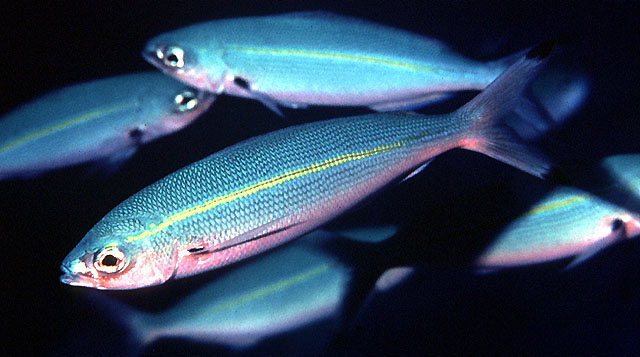| Caesionidae (Fusiliers), subfamily: Caesioninae |
| 25 cm TL (male/unsexed) |
|
reef-associated; marine; depth range 1 - 30 m, non-migratory |
| Indo-West Pacific: Sri Lanka to Vanuatu (New Hebrides). |
|
Dorsal spines (total): 10-11; Dorsal soft rays (total): 14-16; Anal spines: 3-3; Anal soft rays: 11-13. This species is distinguished by the following characters: D X (rarely XI),15 (rarely 14 or 16); A III,12 (11-13); pectoral fin 20-22 soft rays; scales in lateral line usually 69-75, above to dorsal fin origin 9-11 (modally 10) and below to anal-fin origin 11-12; upper peduncular scales usually 11-13; dorsal and anal fins are scaly; obliquely oriented scale rows on posterior back; two postmaxillary processes; small conical teeth in jaws; greatest body depth 3.3-4.4 in SL, head length 3.2-3.7 in SL; colour of body bluish green on upper half, white or silvery blue on lower side (pinkish ventrally); a single yellow longitudinal stripe laterally, about 1 scale wide, covering lateral line for most of its length, usually running dorsal to lateral line on caudal peduncle; caudal fin dusky, the tips of lobes black (Ref. 68703, 90102). |
| Inhabits clear coastal to outer reef slopes or drop-offs (Ref. 48636). Feeds on zooplankton in midwater aggregations. Oviparous, with numerous, small pelagic eggs (Ref. 402). Caught mainly by drive-in-nets. |
|
Least Concern (LC); Date assessed: 09 March 2015 Ref. (130435)
|
| harmless |
Source and more info: www.fishbase.org. For personal, classroom, and other internal use only. Not for publication.
